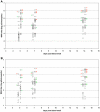The native Wolbachia endosymbionts of Drosophila melanogaster and Culex quinquefasciatus increase host resistance to West Nile virus infection
- PMID: 20700535
- PMCID: PMC2916829
- DOI: 10.1371/journal.pone.0011977
The native Wolbachia endosymbionts of Drosophila melanogaster and Culex quinquefasciatus increase host resistance to West Nile virus infection
Abstract
Background: The bacterial endosymbiont Wolbachia pipientis has been shown to increase host resistance to viral infection in native Drosophila hosts and in the normally Wolbachia-free heterologous host Aedes aegypti when infected by Wolbachia from Drosophila melanogaster or Aedes albopictus. Wolbachia infection has not yet been demonstrated to increase viral resistance in a native Wolbachia-mosquito host system.
Methodology/principal findings: In this study, we investigated Wolbachia-induced resistance to West Nile virus (WNV; Flaviviridae) by measuring infection susceptibility in Wolbachia-infected and Wolbachia-free D. melanogaster and Culex quinquefasciatus, a natural mosquito vector of WNV. Wolbachia infection of D. melanogaster induces strong resistance to WNV infection. Wolbachia-infected flies had a 500-fold higher ID50 for WNV and produced 100,000-fold lower virus titers compared to flies lacking Wolbachia. The resistance phenotype was transmitted as a maternal, cytoplasmic factor and was fully reverted in flies cured of Wolbachia. Wolbachia infection had much less effect on the susceptibility of D. melanogaster to Chikungunya (Togaviridae) and La Crosse (Bunyaviridae) viruses. Wolbachia also induces resistance to WNV infection in Cx. quinquefasciatus. While Wolbachia had no effect on the overall rate of peroral infection by WNV, Wolbachia-infected mosquitoes produced lower virus titers and had 2 to 3-fold lower rates of virus transmission compared to mosquitoes lacking Wolbachia.
Conclusions/significance: This is the first demonstration that Wolbachia can increase resistance to arbovirus infection resulting in decreased virus transmission in a native Wolbachia-mosquito system. The results suggest that Wolbachia reduces vector competence in Cx. quinquefasciatus, and potentially in other Wolbachia-infected mosquito vectors.
Conflict of interest statement
Figures






References
Publication types
MeSH terms
Grants and funding
LinkOut - more resources
Full Text Sources
Other Literature Sources
Medical
Molecular Biology Databases

